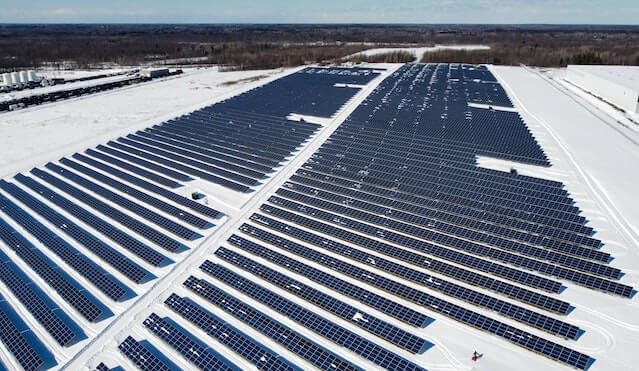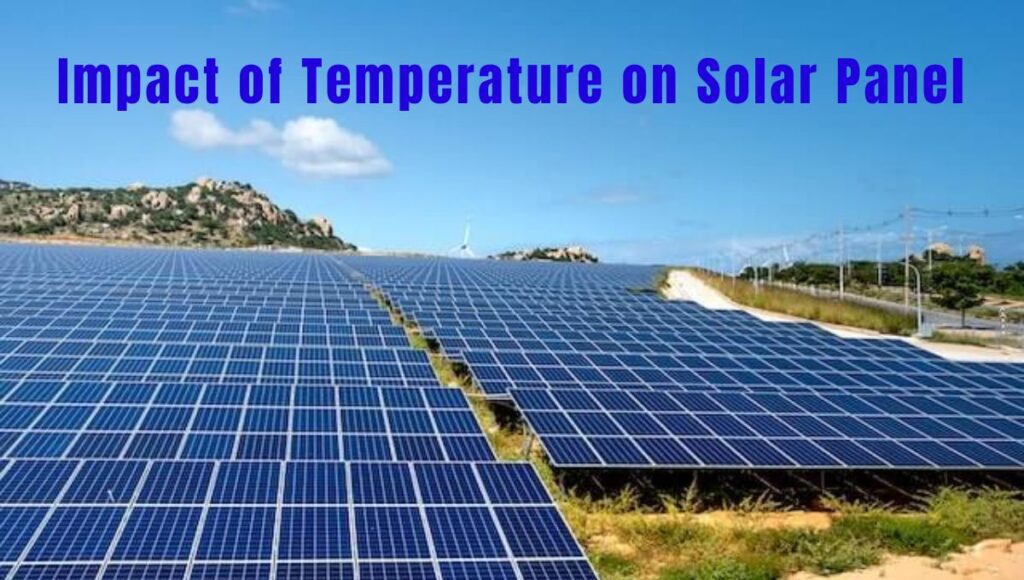Last updated on March 4th, 2025 at 02:43 pm
The impact of temperature on solar panels’ performance is often overlooked. In fact, the temperature can have a significant influence on the output and efficiency of solar panels, and understanding this relationship is essential for optimizing their performance and maximizing energy production.
In this article, we delve deeper into the effects of temperature on solar panel efficiency and explore how temperature fluctuations can affect their overall performance. We will uncover the challenges posed by both hot and cold temperatures, and discuss practical solutions to mitigate these effects.
What is solar panel energy efficiency?
Solar panel energy efficiency refers to the ability of a solar panel to convert sunlight into usable electrical energy. It is a measure of how effectively the solar panel can capture sunlight and convert it into electricity. The efficiency of a solar panel is typically expressed as a percentage and represents the ratio of the electrical energy output of the panel to the amount of solar energy input it receives.
Solar panel efficiency is influenced by various factors, including the quality of the photovoltaic (PV) cells used in the panel, the design and construction of the panel, and external environmental conditions. Higher efficiency means that a greater proportion of the sunlight falling on the solar panel is converted into usable electricity.
The efficiency of solar panels can vary depending on the technology and materials used. Traditional silicon-based solar panels, also known as crystalline silicon solar panels, have achieved significant efficiency improvements over the years and typically have efficiencies ranging from 15% to 20%. There are also newer technologies, such as thin-film solar panels and multi-junction solar cells, that have different efficiency ranges.
It is important to note that solar panel efficiency is tested and rated under standard testing conditions (STC) defined by industry standards. These conditions typically include a temperature of 25°C (77°F), solar irradiance of 1,000 watts per square meter, and an air mass of 1.5. The actual efficiency of a solar panel in real-world conditions may vary due to factors such as temperature, shading, and dirt or dust accumulation on the panel’s surface.

Environmental factors that can affect the performance of solar panels
Solar energy is a clean and renewable source of power, but like any technology, solar panels can be influenced by various external factors. Understanding these factors can help us optimize their performance and make informed decisions when it comes to solar panel installations.
-
Sunlight Intensity: Solar panels rely on sunlight to generate electricity, so the intensity of sunlight plays a crucial role. Ideally, panels perform best under direct sunlight with high irradiance levels. Cloudy or overcast conditions can reduce the amount of sunlight reaching the panels, leading to lower energy production.
-
Shading: Shading is a significant factor that can impact solar panel performance. When a portion of the panel is shaded, whether by trees, buildings, or other objects, it disrupts the flow of sunlight to the shaded area. This can create hotspots on the panel and reduce overall energy production. It’s essential to ensure that panels are installed in a location with minimal shading throughout the day.
-
Temperature: As we discussed earlier, temperature affects solar panel performance. High temperatures can cause a decrease in panel efficiency due to the temperature coefficient. However, it’s worth noting that solar panels still produce electricity even on hot days. They are designed to dissipate excess heat to maintain optimal operating temperatures.
-
Dust and Debris: Accumulation of dust, dirt, leaves, or other debris on the surface of solar panels can hinder their performance. These materials act as barriers, reducing the amount of sunlight that reaches the PV cells. Regular cleaning and maintenance are necessary to ensure maximum energy production.
-
Tilt and Orientation: The tilt angle and orientation of solar panels affect their exposure to sunlight. Panels tilted at an optimal angle and facing south (in the northern hemisphere) maximize sunlight absorption throughout the day. A slight deviation from the ideal angle or orientation may result in decreased energy output.
-
Humidity and Moisture: Solar panels are generally designed to withstand outdoor conditions, including humidity and moisture. However, excessive humidity or prolonged exposure to moisture can lead to corrosion, reduced electrical conductivity, or even damage to the panel’s components. Proper installation and regular inspection can help mitigate these risks.
-
Altitude and Latitude: Altitude and latitude affect the angle and duration of sunlight exposure. At higher altitudes or near the equator, solar panels receive more intense sunlight for a longer duration, resulting in increased energy production. Conversely, at lower latitudes or higher latitudes with shorter daylight hours, panels may produce relatively less energy.
-
Air Quality: The quality of the air surrounding solar panels can impact their efficiency. Air pollution, including smog, particulate matter, or chemical emissions, can create a layer of film on the panel surface, reducing the amount of sunlight reaching the cells. This emphasizes the importance of regular maintenance and cleaning in polluted areas.
Understanding the temperature coefficient of solar panels
The temperature coefficient of solar panels refers to the rate at which the performance of a solar panel changes in response to variations with temperature. It is a measure of how the electrical characteristics of the solar panel, such as voltage and power output, are affected by temperature changes.
The temperature coefficient is typically expressed in percentage per degree Celsius (or percentage per degree Fahrenheit). It provides insight into the panel’s sensitivity to temperature and helps assess the expected changes in performance as temperatures fluctuate.
There are two main temperature coefficients that are commonly used:
Temperature Coefficient of Voltage (TCV): This coefficient indicates how the output voltage of a solar panel changes with temperature. It is expressed as a percentage change in voltage per degree Celsius. A negative TCV value signifies that the voltage decreases as the temperature rises.
Temperature Coefficient of Power (TCP): The TCP describes how the power output of a solar panel changes with temperature. It represents the percentage change in power output per degree Celsius. Similar to TCV, a negative TCP value indicates that the power output decreases as the temperature increases.
By knowing the temperature coefficients, it is possible to estimate the impact of temperature on the performance of solar panels. These coefficients vary depending on the specific design, materials, and manufacturing processes of the panels. Manufacturers typically provide temperature coefficients in the specifications of their solar panels, allowing users to understand and account for the temperature-related changes in performance.
The effect of temperature on solar panels
The temperature has a significant impact on the performance of solar panels. As the temperature rises, the efficiency of solar panels tends to decrease, affecting their power output. Let’s delve into the details of how temperature affects solar panel performance and explore the underlying scientific principles.
When sunlight strikes a solar panel, it generates direct current (DC) electricity through the photovoltaic (PV) effect. However, solar cells are sensitive to temperature changes, and this sensitivity is primarily attributed to two key factors: the temperature coefficient of voltage and the temperature coefficient of power.
The temperature coefficient of voltage refers to how the output voltage of a solar panel changes with temperature. Typically, the output voltage decreases as the temperature rises. On average, for every degree Celsius above 25°C (77°F), the voltage decreases by around 0.3% to 0.5%. This reduction in voltage results in a decrease in power output.
The temperature coefficient of power reflects how the power output of a solar panel changes with temperature. As the temperature increases, the power output decreases, albeit at a slightly slower rate compared to the voltage. The temperature coefficient of power is influenced by various factors, including the materials used in the solar cells and the specific design of the panel.
To provide some context, let’s consider the performance of a typical solar panel. At a standard test condition (STC) of 25°C (77°F), a solar panel may have an efficiency of around 15% to 20%. However, when the temperature increases to 35°C (95°F) or higher, the efficiency can decrease by around 1% to 2%. In extremely hot conditions, such as deserts, where temperatures can exceed 40°C (104°F), the efficiency loss can be even more pronounced.
This temperature-related decrease in efficiency can be explained by several factors. First, as the temperature rises, the movement of electrons within the solar cells increases, leading to more resistance and losses in the electrical current. Second, higher temperatures can cause an increase in the energy bandgap of the semiconductor materials used in solar cells, reducing their ability to absorb and convert sunlight into electricity effectively.
It is important to note that the decrease in efficiency with temperature is not linear. The relationship between temperature and efficiency varies depending on the specific characteristics of the solar panel, including its design, materials, and manufacturing processes. Different types of solar panels may exhibit different temperature coefficients, resulting in varying levels of performance degradation.
How hot do solar panels get?
Solar panels can get quite hot, especially under direct sunlight. The exact temperature that solar panels can reach depends on various factors, including ambient temperature, sunlight intensity, panel design, and ventilation. On a sunny day, solar panels can heat up to temperatures ranging from 25°C (77°F) to 65°C (149°F) or even higher.
While solar panels are designed to withstand high temperatures, excessive heat can affect their performance and longevity. Overheating can lead to a decrease in energy production and potentially damage the panels if the temperature rises to extreme levels.
However, it’s important to note that solar panels are equipped with built-in mechanisms to dissipate heat and maintain optimal operating temperatures. These mechanisms include the use of heat-resistant materials, ventilation gaps, and heat sinks that help transfer excess heat away from the solar cells.

What happens when the temperature of solar panels increases?
When the temperature of solar panels increases, several effects can occur, impacting their performance and efficiency. Here are the key changes that take place:
Reduction in efficiency
As the temperature rises, the efficiency of solar panels tends to decrease. This is primarily due to the behavior of the semiconductor materials within the panels. Higher temperatures increase the internal resistance of the materials, which in turn reduces the flow of electrons and hampers the panel’s ability to convert sunlight into electricity. Consequently, the power output of the panels decreases.
Voltage decrease
Solar panels produce direct current (DC) electricity, and their voltage is affected by temperature. Typically, solar panels have a negative temperature coefficient, meaning that the voltage decreases as the temperature increases. This decrease in voltage can affect the overall performance of the solar power system, especially in terms of energy conversion and power delivery.
Degradation of materials
Prolonged exposure to high temperatures can lead to the degradation of materials used in solar panels. Over time, excessive heat can cause the soldering connections between cells to deteriorate, leading to reduced panel performance and potential failure. Additionally, high temperatures can accelerate the aging process of the panel components, shortening their lifespan and overall durability.
Increased thermal losses
Solar panels generate heat as a byproduct of converting sunlight into electricity. When the ambient temperature is already high, the additional heat produced by the panels can exacerbate thermal losses. This can further reduce the efficiency of the panels and decrease their overall power output.
How to mitigate the effects of temperature on solar panel efficiency?
As the temperature rises, solar panel efficiency can take a hit. However, there are several strategies you can employ to mitigate the effects of temperature and maximize the performance of your solar panels. Let’s explore some of these techniques:
Optimal panel placement
The location and orientation of your solar panels play a crucial role in temperature management. Positioning them in a way that minimizes direct exposure to intense sunlight can help prevent excessive heating. Additionally, ensuring proper spacing between panels allows for better airflow, which aids in dissipating heat and maintaining lower operating temperatures.
Enhanced ventilation and cooling
Improving the ventilation around your solar panels can help dissipate heat more effectively. This can be achieved by using raised mounting systems that allow air to circulate beneath the panels. Additionally, incorporating cooling mechanisms such as fans, heat sinks, or water circulation systems can further enhance heat dissipation and prevent panel overheating.
Selecting temperature-resistant materials
When choosing solar panels, consider opting for models that are designed to withstand high temperatures. Certain materials and coatings are specifically formulated to handle extreme heat conditions, ensuring better performance and longevity even in hot climates.
Implementing shading techniques
By providing shade for your solar panels, you can protect them from direct exposure to intense sunlight and reduce the temperature they are exposed to. This can be achieved by using structures like pergolas, awnings, or vegetation to create a shaded area around the panels. However, it’s important to strike a balance between shade and sunlight to ensure sufficient energy generation.
Monitoring and maintenance
Regular monitoring of your solar panel system allows you to identify any issues or deviations in performance promptly. By detecting and addressing problems related to temperature, such as excessive heating or hotspots, you can prevent further damage and optimize the system’s efficiency. Routine maintenance, including cleaning the panels to remove dust or debris that can contribute to increased temperatures, is also crucial.
System design considerations
When designing a solar power system, factors such as the number of panels, wiring configuration, and inverter selection can impact temperature management. Consulting with a professional installer or engineer who can analyze your specific requirements and provide guidance on system design can ensure that temperature-related challenges are addressed effectively.
By implementing these strategies, you can minimize the adverse effects of temperature on solar panel efficiency. It’s essential to consider the unique environmental conditions of your location and customize your approach accordingly. Remember, a well-maintained and properly managed solar panel system will not only improve energy generation but also enhance the overall longevity and performance of your investment.
The ideal temperature for achieving the best efficiency of solar panels
The ideal temperature for achieving the best efficiency of solar panels depends on various factors, including the specific type of solar panel technology used. However, as a general guideline, solar panels tend to perform optimally in moderate temperatures. Typically, the temperature range of 25°C to 35°C (77°F to 95°F) is considered favorable for achieving the highest efficiency.
When solar panels operate within this temperature range, their performance is maximized, and they can convert sunlight into electricity more efficiently. Outside this range, either at lower or higher temperatures, the efficiency of solar panels may start to decline.
How does cold temperature affect solar panel output?
Cold temperatures can have both positive and negative effects on solar panel output. Initially, cold temperatures can increase the conductivity of the solar panel’s semiconductor material, allowing electrons to move more freely. This can result in a slight boost in voltage and overall power output. However, as the temperature continues to drop, the negative effects start to outweigh the positive ones.
One of the primary challenges in cold weather is the decrease in sunlight intensity. Winter months often bring shorter days and lower solar irradiance due to cloud cover or shorter daylight hours. This reduction in available sunlight can limit the energy production of solar panels.
Additionally, colder temperatures can lead to increased resistive losses within the solar panel system. The internal resistance of the panels and other components, such as wiring and connections, can rise as the temperature drops. This increased resistance causes a voltage drop, reducing the overall power output of the system.
Cold temperatures can also impact the efficiency of solar panels due to the temperature coefficient. The temperature coefficient represents the rate at which the panel’s efficiency decreases with every degree Celsius drop in temperature. Different solar panel technologies have varying temperature coefficients, but as a general rule, colder temperatures can lead to a decrease in the panel’s overall efficiency.
Snow accumulation is another factor to consider in cold climates. When snow covers the solar panels, it blocks sunlight and prevents energy generation. It is crucial to remove snow from the panels to ensure uninterrupted operation and optimize energy production during winter months.
To mitigate the negative effects of cold temperatures on solar panel output, several measures can be taken. One approach is to install the panels at an angle or position that allows sunlight to hit them more directly, promoting better snow shedding and optimizing energy capture.
Heating systems or techniques can also be implemented to prevent snow accumulation or facilitate its natural melting process. Additionally, regular maintenance, including cleaning the panels and ensuring proper electrical connections, can help maintain optimal performance in cold weather conditions.

Conclusions
The temperature has a significant impact on the performance and efficiency of solar panels. Both hot and cold temperatures can affect the output of solar panels, albeit in different ways. In hot climates, high temperatures can lead to a decrease in efficiency due to increased resistance, reduced voltage, and lower power output.
On the other hand, cold temperatures can initially boost the conductivity and voltage output of solar panels, but prolonged exposure to extreme cold can result in decreased sunlight availability, increased resistive losses, and reduced panel efficiency.
To mitigate the effects of temperature on solar panel efficiency, certain measures can be taken. In hot regions, proper ventilation and cooling systems can help dissipate heat and prevent overheating.
This can be achieved through the use of air circulation, shade structures, or even water-based cooling systems. In cold regions, the installation of panels at optimal angles, regular snow removal, and implementation of heating systems can help maintain performance and prevent snow accumulation.

